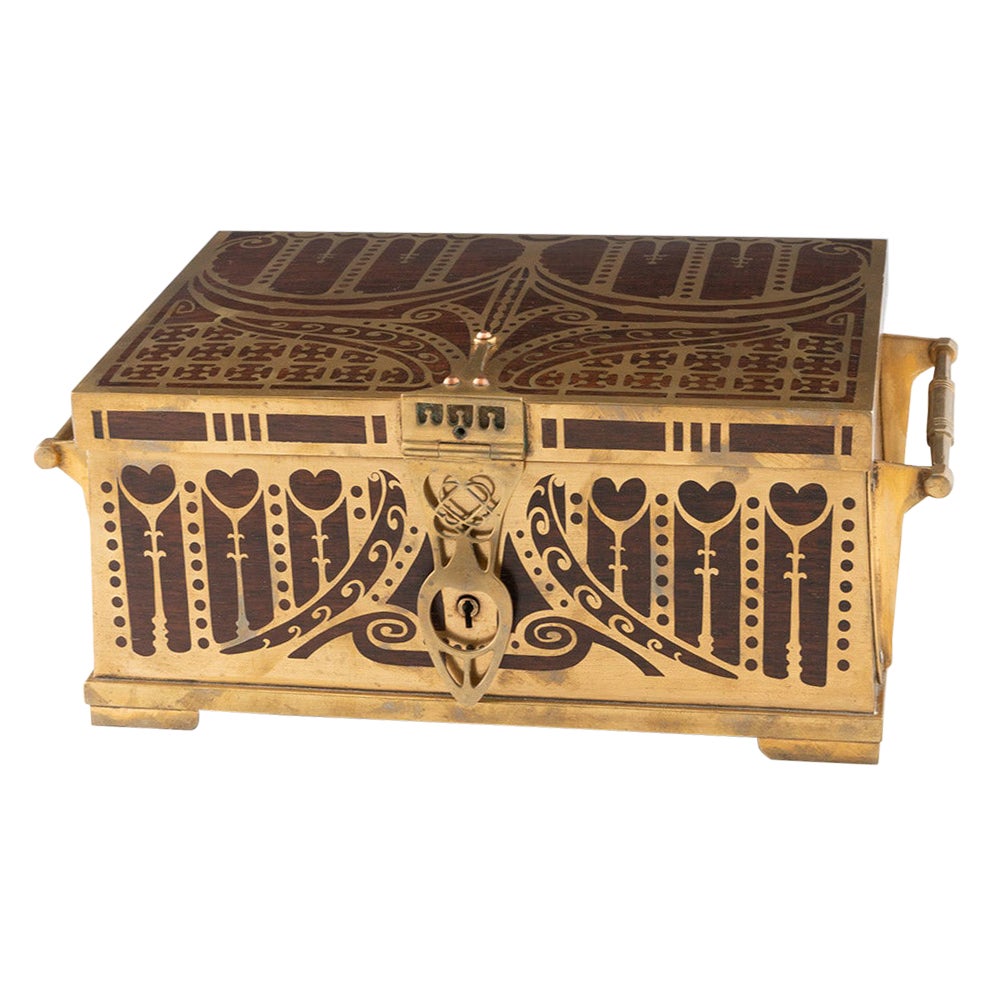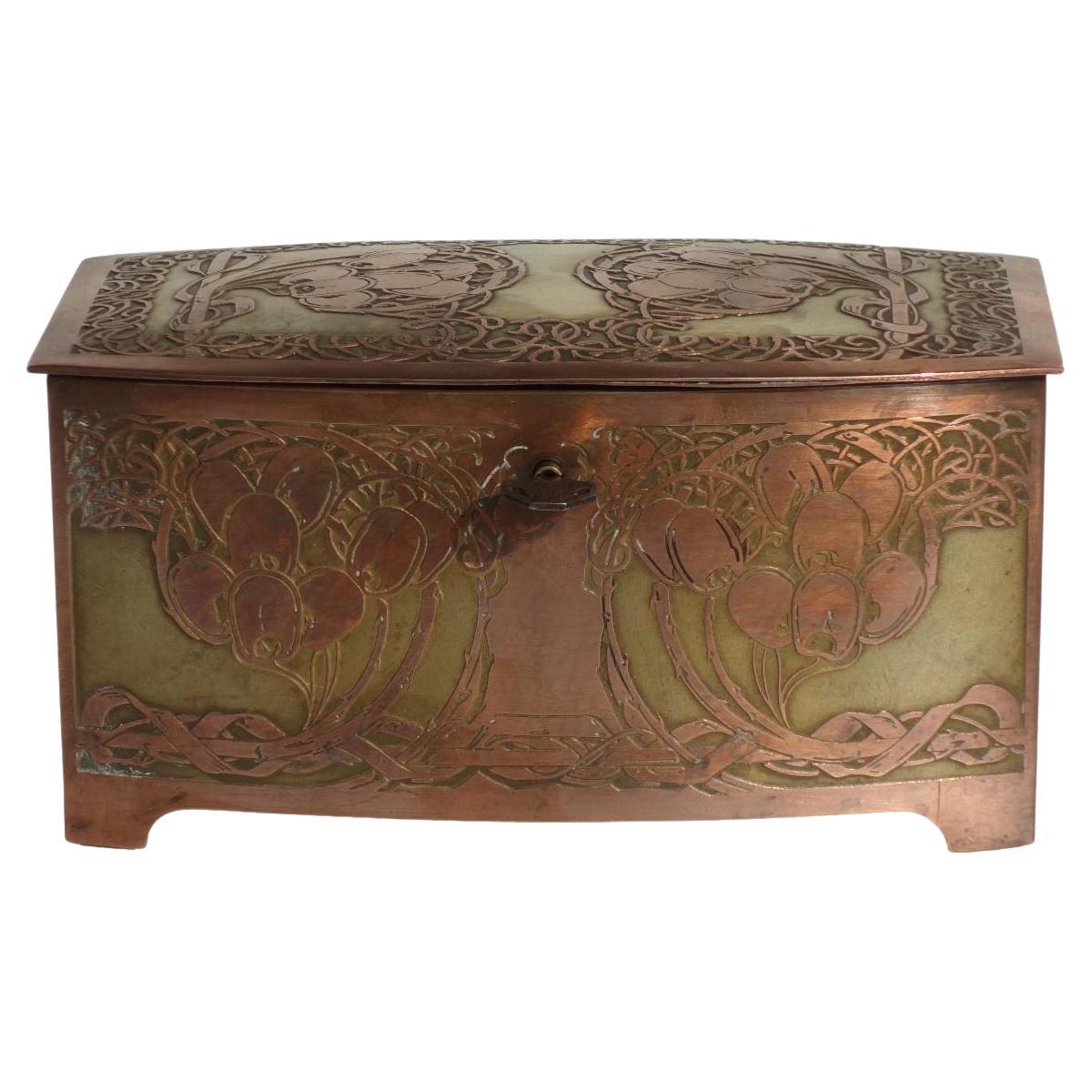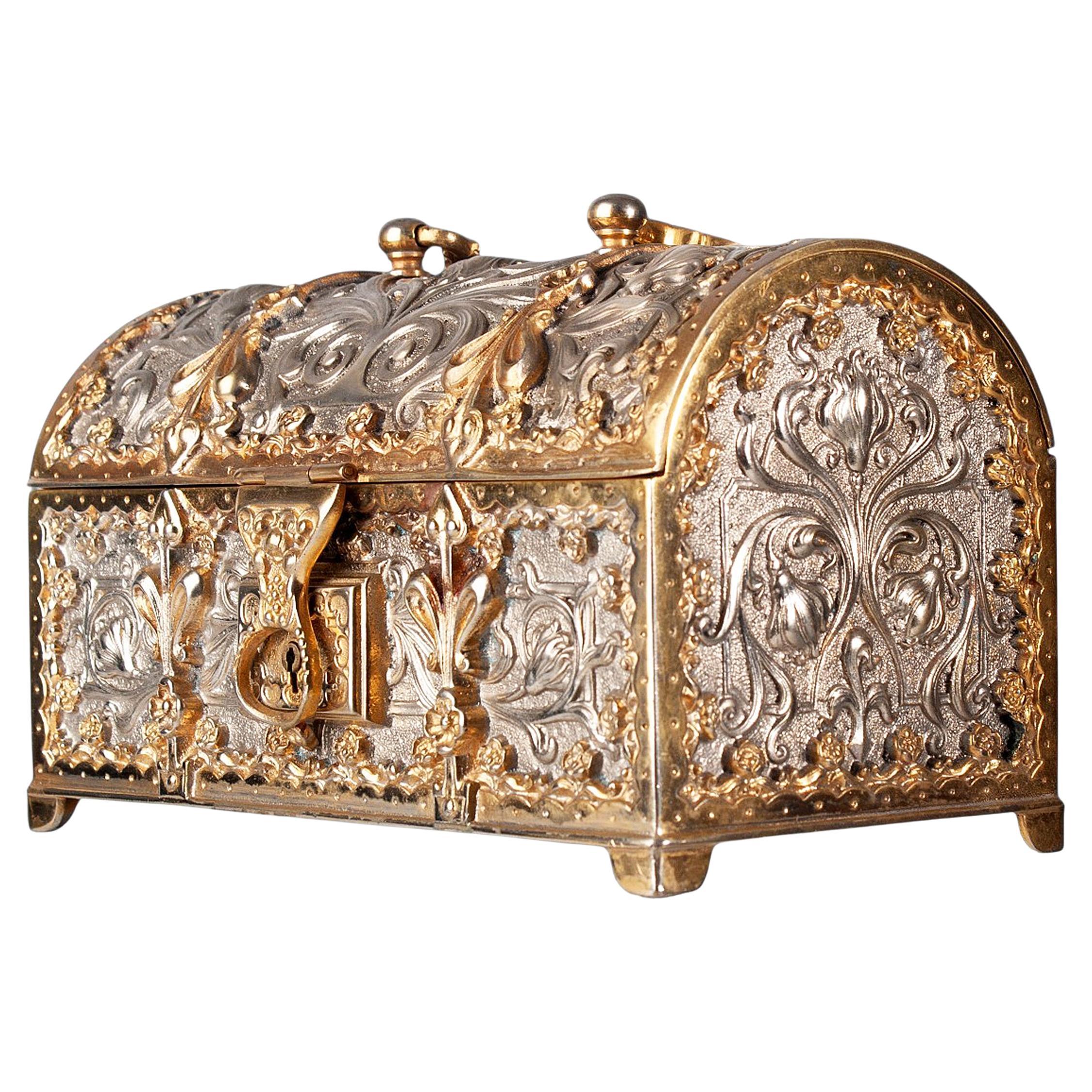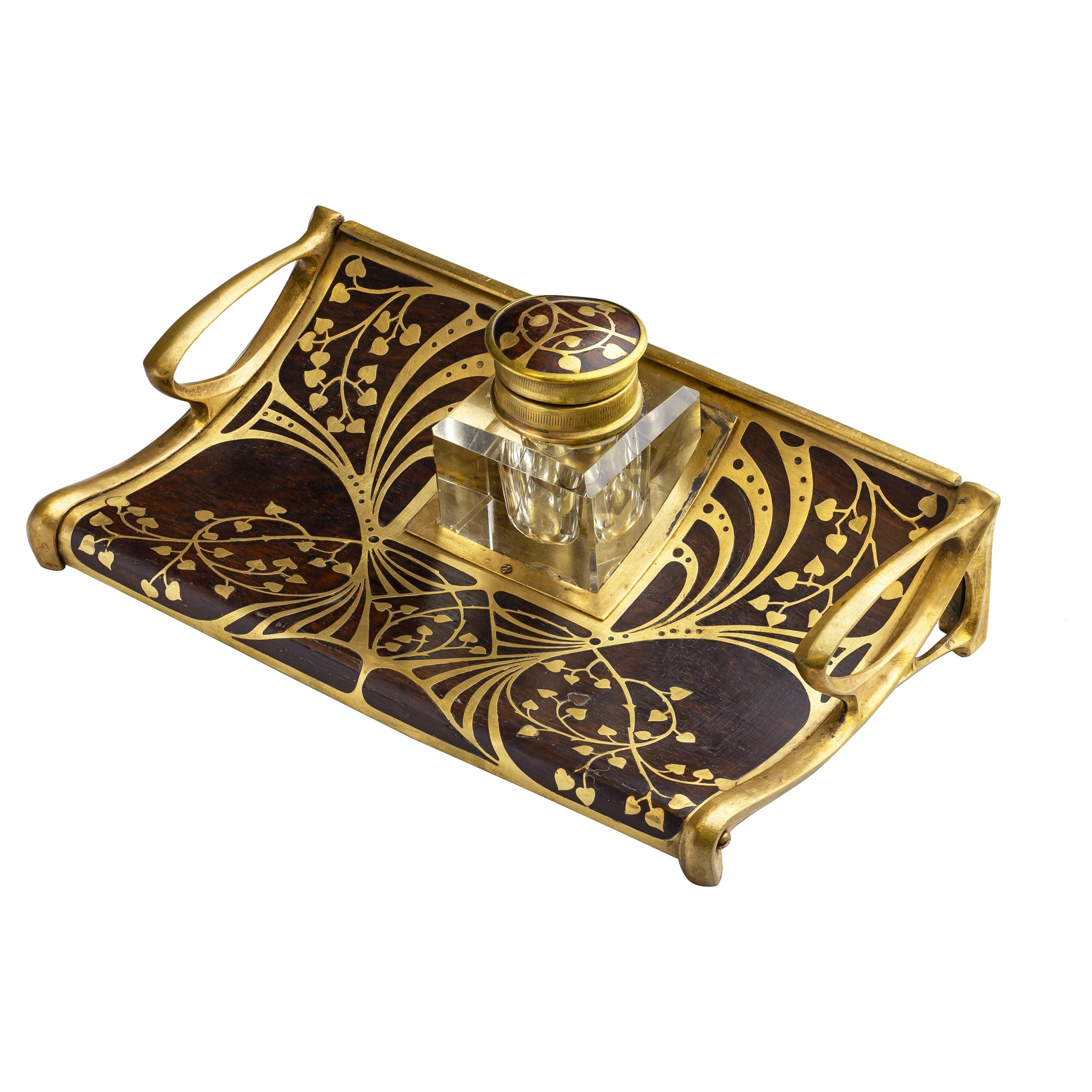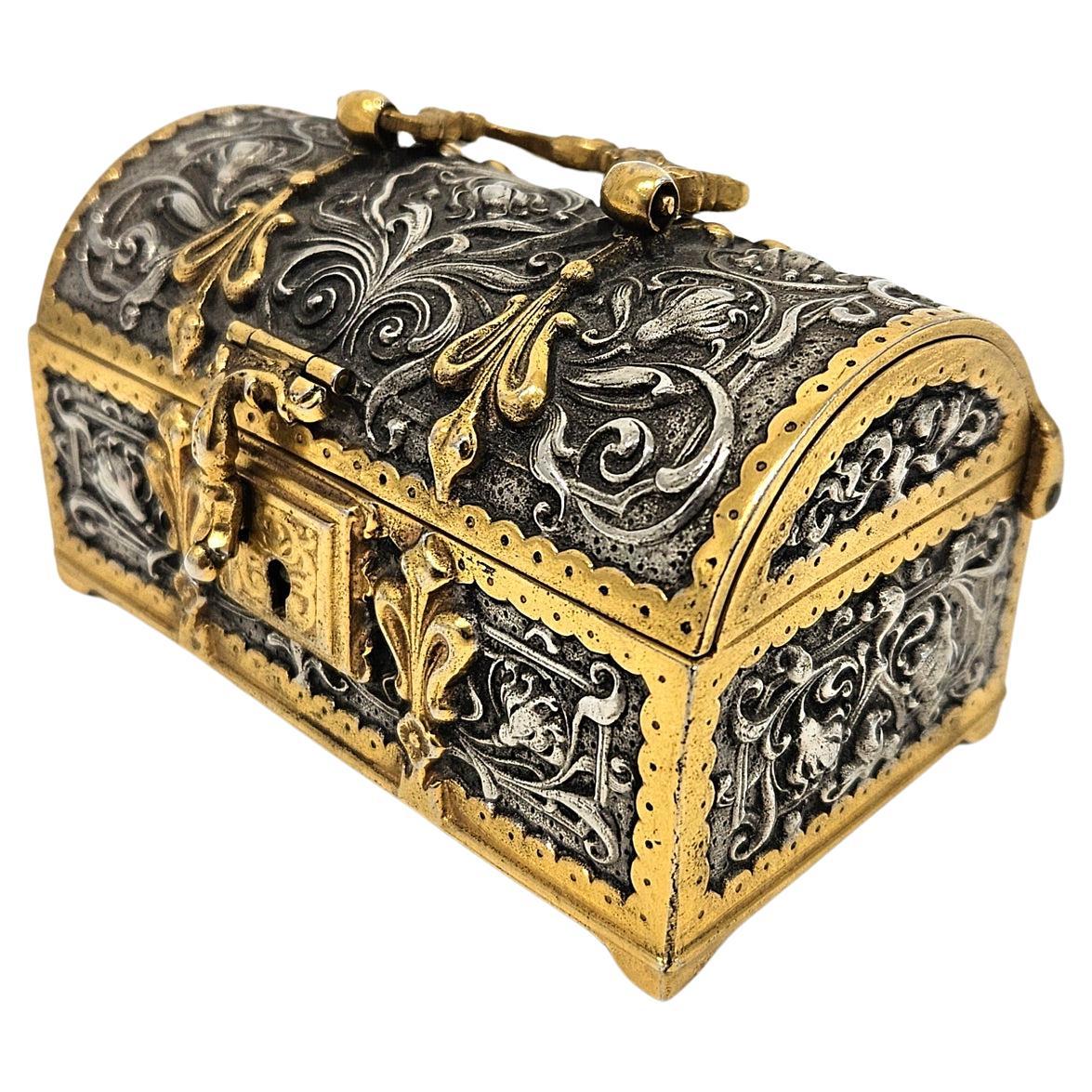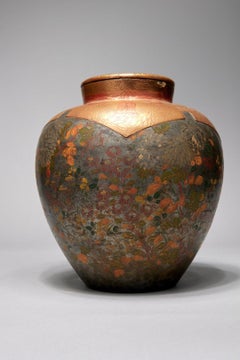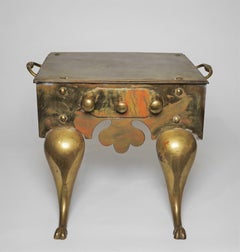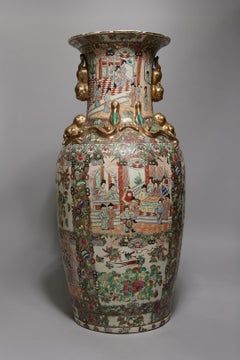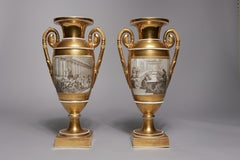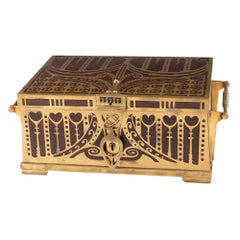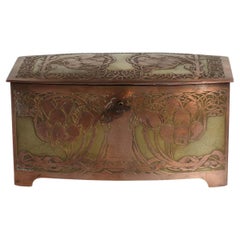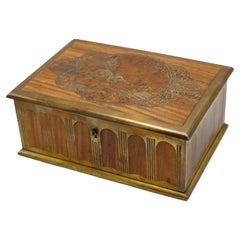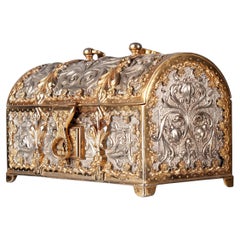Objekte ähnlich wie Erhard & Söhne Art Nouveau Jugendstil Jewelry Casque w/ Inlaid Brass Rose Design
Video wird geladen …
Möchten Sie mehr Bilder oder Videos?
Zusätzliche Bilder oder Videos von dem*der Anbieter*in anfordern
1 von 14
Erhard & SöhneErhard & Söhne Art Nouveau Jugendstil Jewelry Casque w/ Inlaid Brass Rose Designc. 1904
c. 1904
3.050,02 €
Angaben zum Objekt
Erhard & Söhne, 19th Century
Art Nouveau Jugendstil Casque with Inlaid Brass Rose Design, c. 1904
6 x 9 x 6 inches
The company Erhard & sons was established by Carl Gottlieb Erhard and his two sons in Schwäbisch Gmünd in 1844. Carl Gottlieb Erhard, the priest-son from Großheppach, setteled in Schwäbisch Gmünd when he marriged Debler-Tochter. He became a partner of the company Teilhaber der Firma Gerber & Co, and acquired it with a settlement of 100.000 guilders in 1843. He established the company Erhard & Söhne with help of the sons Carl and Julius in 1844, which is today the oldest producing factory in the city continued in sixth generations as the single family business.
Carl Gottlieb Erhard procured to fill the market gap that the fire gilt hardwares were bought abroad at very expensive price. So he gathered highly trained experts for his business around a market, also his sons got the best education as Ziseleur and engraver. Julius was the creative one, Carl the commercial leader, on this occasion.
Their business wrote the history of the city henceforth. They especially specialized on fashionable accessoires (Galanteriewaren) of all the type out of brass and bronze, sometimes silver-plates or gilds. Highest skill was applied in their miniature-works, especially Doll-room-furnitures were sought-after items for the collectors, which inclue bookbinders, glove, buttons, buckles, etc.
At the beginning their main markets were England, America and the German states which ware not unified yet. In 1864 the factory was enlarged. The company tried new inventions again and again and was called "Testing factory". Soon the company had 3000 employees that it build another factory-building in 1900.
Besides the specialization at the processing of bronze, brass, copper and tin, also articles of noble-metal were manufactured. With the world-patent for the manufacture of brass-inlay (1904), the production of doll-room-accessories and furnitures out of gilt brass, that the big export-hit was between 1900 and 1910 into the USA, the business finally won world-format, and the invention of the Schleuderaschers (spin-ashtray), Roulette type ash tray (1938). The company was granted the patent for the thermo-mug in 1956. The extensive product spectrum of the business included extravaganzas - churches-use, luxury-goods, cult-appliances, jewelry and game-merchandise as well as electrotype-plastic copies of historic culture-objects.
This company is very known in the collector-scene as much sought after items for the antique doll-rooms since the company produced the highest quality Ormolu doll-room-accessories and furnitures until mid-1920s. Golden years of the company were the first years of the 20th century. When it was put on the mechanical engineering more and more and with the game-merchandise-production, it went downhill.
Since 1945, the company Erhard & sons was in particular decisive at the development and production the world-wide in use of brought Unimog (Universal-Motor-Gerät) involves. After the World War II it is an important factory of tanks under the name Erhard Automotive for usefulness-vehicles.
Today, the company is all over Europe from motor vehicle-sharing on topmost technical level one of the leading manufacturers. The transition of the manual Einzelanfertigung of historistischem art-trade to the mass-production of later industry-design joins with it with the history of the business at the same time.
Erhard & Sohne had the world-patent for the manufacture of brass-inlay in 1904. Since then they designed and manufuctured high-quality brass-inlay boxes and items which represented very unique and noble German Art-Nouveau style at its peak.
Some important works by Erhard & Sohne were illustrated in "MODERN ART OF METALWORK. Bröhan-Museum State Museum of Art Nouveau, Art Deco and Functionalism (1889-1939), Berlin" published by Bröhan-Musuem in 2001. The Bröhan-Musuem is one of the most prominent museums specialised in Art Nouveau, Art Déco and the Berlin Secession.
Anbieterinformationen
5,0
Platin-Anbieter*in
Premium-Anbieter*innen mit einer Bewertung über 4,7 und 24 Stunden Reaktionszeit
Gründungsjahr 1975
1stDibs-Anbieter*in seit 2022
35 Verkäufe auf 1stDibs
Typische Antwortzeit: <1 Stunde
- VersandAngebot wird abgerufen …Versand von: Beachwood, OH
- Rückgabebedingungen
Einige Inhalte dieser Seite wurden automatisch übersetzt. Daher kann 1stDibs nicht die Richtigkeit der Übersetzungen garantieren. Englisch ist die Standardsprache dieser Website.
Authentizitätsgarantie
Im unwahrscheinlichen Fall eines Problems mit der Echtheit eines Objekts kontaktieren Sie uns bitte innerhalb von 1 Jahr für eine volle Rückerstattung. DetailsGeld-Zurück-Garantie
Wenn Ihr Objekt nicht der Beschreibung entspricht, beim Transport beschädigt wurde oder nicht ankommt, kontaktieren Sie uns bitte innerhalb von 7 Tagen für eine vollständige Rückerstattung. DetailsStornierung innerhalb von 24 Stunden
Sie können Ihren Kauf jederzeit innerhalb von 24 Stunden stornieren, ohne jegliche Gründe dafür angeben zu müssen.Geprüfte Anbieter*innen
Unsere Anbieter*innen unterliegen strengen Dienstleistungs- und Qualitätsstandards, wodurch wir die Seriosität unserer Angebote gewährleisten können.Preisgarantie
Wenn Sie feststellen, dass ein*e Anbieter*in dasselbe Objekt anderswo zu einem niedrigeren Preis anbietet, werden wir den Preis entsprechend anpassen.Zuverlässige weltweite Lieferung
Unsere erstklassigen Versandunternehmen bieten spezielle Versandoptionen weltweit, einschließlich individueller Lieferung.Mehr von diesem*dieser Anbieter*in
Alle anzeigenChinesisches verziertes Metallgefäß mit Deckel aus dem späten 19. Jahrhundert im japanischen Stil
Chinesisch Ende 19. Jahrhundert
Dekoriertes Ingwerglas mit Metalldeckel im japanischen Stil
Unten beschriftet Ralph M. Chait Galleries, New York
9 x 7,5 x 7,5 Zoll
Ingwerkrüge wu...
Kategorie
Spätes 19. Jahrhundert, Mehr Kunstobjekte
Materialien
Metall
Englischer Doppelgriff-Fußgänger aus dem 18.
Englischer Doppelgriff-Läufer, 18. Jahrhundert
Messing
12 x 18 x 17 Zoll
Kategorie
18. Jahrhundert, Mehr Kunstobjekte
Materialien
Messing
Monumentale chinesische Medaillonvase in Famille Rose, 20. Jahrhundert
Monumentale chinesische Medaillonvase in Famille Rose, 20. Jahrhundert
Porzellan
36 x 18 Zoll
Famille rose ist ein chinesisches Porzellan des 18. Jahrhunderts, das sich durch seine ...
Kategorie
20. Jahrhundert, Mehr Kunstobjekte
Materialien
Porzellan
Paar französische Goldurnen aus Porcelaine de Paris mit Szenen aus der römischen Geschichte
Paar französische Goldurnen aus Porzellan de Paris mit Szenen aus der römischen Geschichte, frühes 19.
13 x 6,5 x 5 Zoll
Auf dem Sockel einer Urne steht "Tibrius Gracchus Ferme Le T...
Kategorie
Frühes 19. Jahrhundert, Mehr Kunstobjekte
Materialien
Porzellan
Botanical-Motive aus der Mitte des Jahrhunderts, dekorativer blauer + grüner Teller, Cleveland School
Kenneth Bates (Amerikaner, 1904-1994)
Botanische Motive, 1953
Emaille
Signiert und datiert auf dem Boden
9 Zoll
Kenneth Bates, der in einer Ausgabe der Zeitschrift Ceramics Monthly...
Kategorie
1950er, Mehr Kunstobjekte
Materialien
Emaille
Junges Mädchen mit Tauben und Blumenkorb, französische Bronze, 19. Jahrhundert
Isidore Romain Boitel (Franzose, 1812 - 1861)
"Jeune fille aux colombes et à la corbeille de fleurs".
Junges Mädchen mit Tauben und Blumenkorb
Bronze
Signiert auf dem Sockel, Gießer...
Kategorie
Mittleres 19. Jahrhundert, Figurative Skulpturen
Materialien
Bronze
Das könnte Ihnen auch gefallen
Erhard und Söhne Jugendstil Schmuckschatulle um 1900
Von Erhard & Söhne
Überschrift : Erhard und Söhne Jugendstil-Schmuckschatulle um 1900
Zeitraum : Jahrhundertwende
Herkunft : Deutschland
Dekoration : Messingeinlagen aus Palisander mit verschiedenen...
Kategorie
Antik, Frühes 20. Jhdt., Deutsch, Art nouveau, Schmuckkästchen
Materialien
Messing
1900 Erhard und Sohne Secessionist Jugendstil Jugendstil Kupfer-Messing Gehäuse
Von Erhard & Söhne
Jugendstil-Box-Set
Deutschland, 1900-1909
Schatulle aus Kupfer und Messing
Blumige Dekoration
Komplett mit Schlüssel
Marcho gestempelt unter dem Sockel
Seltenes Objekt
Ausgezeichne...
Kategorie
Antik, Early 1900s, German, Wiener Secession, Schmuckkästchen
Materialien
Messing, Kupfer
Jugendstil-Dose von Erhard & Söhne
Eine rechteckige Dose im Jugendstil mit Bob-Motiv Entworfen und hergestellt von Erhard & Söhne. Wurzelholz und Messing. Die Messingintarsie auf der Oberseite zeigt einen Bob mit eine...
Kategorie
Antik, Frühes 20. Jhdt., Österreichisch, Art nouveau, Dekoboxen
Materialien
Messing
Jugendstil-Schmuckschatulle aus Messing mit Samtauskleidung von Erhard & Söhne, Deutschland
Von Erhard & Söhne
Jugendstil-Schatulle aus goldenem und silbernem Messing mit blauer Samtauskleidung von Erhard & Söhne, Deutschland, um 1900
von: Erhard & Söhne
MATERIAL: Messing, Kupfer, Metall, Sa...
Kategorie
Antik, Frühes 20. Jhdt., Deutsch, Jugendstil, Schmuckkästchen
Materialien
Metall, Messing, Kupfer, Zink
Jugendstil-Tintenfass & Tablett Erhard & Söhne zugeschrieben
Dieses Tintenfass aus Messing und Palisanderholz mit Ständer wurde in Deutschland in der Zeit des Jugendstils hergestellt und wird dem Hersteller Erhard & Söhne zugeschrieben. Der ve...
Kategorie
Frühes 20. Jahrhundert, Deutsch, Jugendstil, Schreibtischzubehör
Materialien
Messing
Jugendstilschmuckkästchen-Kasten Kasten von Erhard & Sohne, Deutschland, um 1905
Von Erhard & Söhne
Eine schöne Jugendstilschatulle, hergestellt von Erhard und Sohne in Deutschland um 1905.
Die Schatulle ist exquisit ausgeführt mit blattförmigen...
Kategorie
Frühes 20. Jahrhundert, Deutsch, Art nouveau, Dekoboxen
Materialien
Messing
